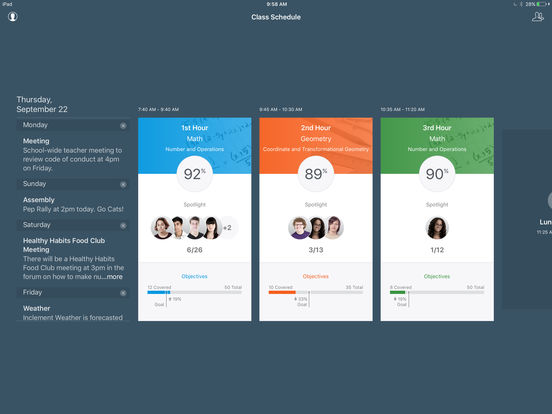| IBM Watson and Education in the Cognitive Era |
| Written by Nikos Vaggalis | |||
| Monday, 28 November 2016 | |||
|
IBM's seemingly ubiquitous Watson is now infiltrating education, through AI powered software that 'reads' the needs of individual students in order to engage them through tailored learning approaches. This is not to be taken lightly, as it opens the door to a new breed of technologies that will spearhead the education or re-education of the workforce of the future. As outlined in the 2030 report, despite robots or AI displacing a big chunk of the workforce, they will also play a major role in creating job opportunities as never before.In such a competitive landscape, workers of all kinds, white or blue collar to begin with, should come readied with new, versatile and contemporary skills. The point is, the very AI that will leave someone jobless, will also help him to re-adapt into a new job's requirements.It will also prepare the new generations through the use of such optimal methodologies that will once more give meaning to the aging and counter-productive schooling system which has the students' skills disengaged from the needs of the industry and which still segregates students into 'good' and 'bad'. Might it be that 'bad' students become just like that due to the system's inability to stimulate their interest? Of course, nowadays there are many paths to alternative forms of education, such as MOOCS, Codeschools or Basecamps. The problem, especially with MOOCS, is the high dropout rate since most of their participants are people already holding some sort of degree, BSc, MSc or otherwise, who see MOOCS as a complementary tool in keeping them in sync with the latest industry advancements and not as the primary source of gaining job-worthy skills. As such they're not eager to stick to the deadlines, do the homework or even complete the course. The next issue with any of the current educational solutions is that of personalization; the focus is on the forest and not on the tree, treating the student force as a mass and not as a collection of individuals. As such, the experience of students completing the course in order to just acquire the diploma necessary in landing a job, drawing no enjoyment from the process; unhappy student to unhappy employee. Watson aims to reverse that trend, by aiding and not replacing the teacher, in an attempt to end the 'one size fits all' state of education. This falls into the Assistive AI category which takes cares of the dull, common and time consuming tasks, in this case the administrative ones the teacher has to go through, in order to give him that time back to rather spend it on catering for his students' needs. That's not all though; through understanding each student's learning patterns, it promts the educator into incorporating alternative teaching methods or modifying the curriculum to accommodate the needs and expectations of the students. So how does Watson facilitate all this? In order to do its magic, Watson relies on academic, social, and behavioural data collected from various sources on each student. The data entry flow is continuous as the teacher complements the student's profile by exchanging information with his colleagues, since having a good idea of the student's personality and not just of his academic abilities, arms the teacher with the insight necessary to offer personalized training. Through advanced metrics, Watson gives the heads up to the educator on which students are mastering, striving, or struggling with Finally, through the use of cognitive tutoring, Watson will soon be able to offer autonomous learning solutions that 'read' the students needs, by interacting with them through vision and speech in natural language, in order to make them aware of the gaps in their knowledge and guide them through the process of self correction. After all, it's where AI excels; understanding, reasoning, learning and interacting in a way profitable to its human operator. The software realization of these ideas is taking place in IBM's Watson Element for Educators app for iOS enabled devices: The Watson Element app puts critical insights into educator’s hands powering their ability to track and assess individual students and modify instruction as they move through their classroom and their day. Watson Element provides teachers a wealth of essential student details — about performance, goals and behavior — to give a more comprehensive picture of each student, and to help prioritize those needing targeted learning plans. Element for Educators is the offspring of the IBM MobileFirst for iOS initiative which oversees a tight cooperation between IBM and Apple that: combines the power of enterprise data and analytics with an elegant user experience, to fundamentally redefine how enterprises empower their professionals to interact, learn, connect, and perform. Android fans will be left disappointed through its absence on their platform. The app is currently undergoing rigorous on site testing in a US school district, with the option to expand further if the tests prove satisfactory. The app is available through the Apple store and can be downloaded from here. Despite the long list of benefits, the issue with such a technology is that while it caters very well for the technical aspect of education; what about the aspect of pedagogy? As Wikipedia sets it : The pedagogue's job is usually distinguished from a teacher's by primarily focusing on teaching children life-preparing knowledge such as social skills and cultural norms. There is also a very big focus on care and well-being of the child. Many pedagogical institutions also practice social inclusion. The pedagogue's work also consists of supporting the child in their mental and social development. It's a field where the human element is irreplaceable, where no machine or AI can make up for it, because let's not forget that, school is, or in any case should be, both the centre of developing skill and the gate the student has to go through in order to join society as a well prepared citizen, whatever that means. "Ancient greek man with wax tablet" picture by Pottery Fan
More InformationRelated ArticlesHow Will AI Transform Life By 2030? Initial Report IBM, Slack, Watson and the Era of Cognitive Computing $200 Million Investment In IBM Watson To be informed about new articles on I Programmer, sign up for our weekly newsletter, subscribe to the RSS feed and follow us on Twitter, Facebook or Linkedin.
Comments
or email your comment to: comments@i-programmer.info |
|||
| Last Updated ( Tuesday, 29 November 2016 ) |



